[Korea JoongAang Daily] [Meet the President] KAIST's president wants campus to be a playground
저작권자 ⓒ Korea JoongAng Daily(https://koreajoongangdaily.joins.com/r)무단전재 및 재배포 금지
관련기사 바로가기
[Meet the President] KAIST's president wants campus to be a playground
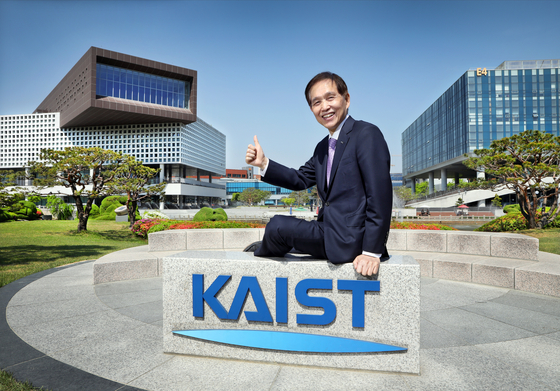
An ardent champion of innovation and entrepreneurship, KAIST President Lee Kwang-hyung hopes
that his students and professors would think of the school as a playground where fun ideas abound. [PARK SANG-MOON]
Globalization is the goal of many Korean universities as they seek to attract bright minds from all corners of the world. Attracting foreign students to campuses is crucial for a country whose demographics are swiftly changing. Last year, Korea hosted more than 150,000 international students despite the Covid-19 pandemic, mostly from Asian countries. In its “Meet the President” series, the Korea JoongAng Daily asks presidents of prominent Korean universities to explain their schools' globalization strategies. -Ed.
KAIST is famous for many things; research in science and technology, innovation, entrepreneurship, intellectual brilliance – and Lee Kwang-hyung.
Better known as the “eccentric professor,” Lee, the president of KAIST, has made a name for himself in Korean academia for breaking the mold and pushing his students to “study less and fail more,” a necessary mindset that he believes paves the way for groundbreaking ideas.
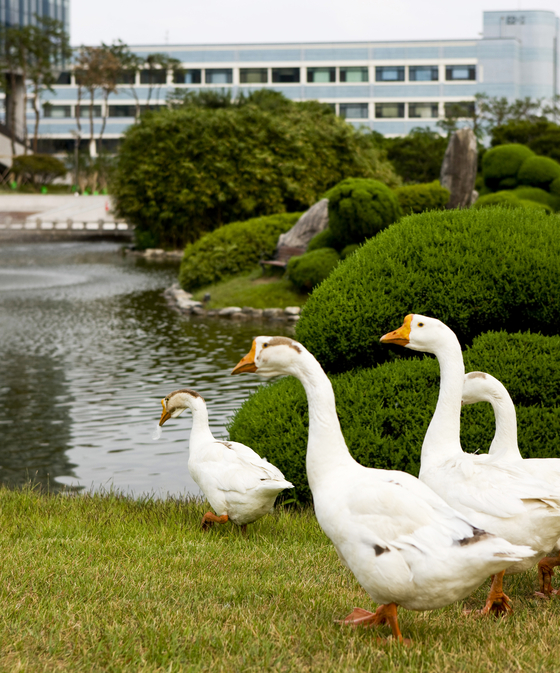
Flocks of ducks and geese can be easily spotted on campus ever since Lee adopted them from a nearby
market in 2001 when he was a professor to bring vitality to the “static” school pond. [KAIST]
Better known as the “eccentric professor,” Lee, the president of KAIST, has made a name for himself in
Korean academia for breaking the mold and pushing his students to “study less and fail more,” a necessary
mindset that he believes paves the way for groundbreaking ideas.
Ever since he was the model for a character in the hit TV series “KAIST” (1999-2000), Lee has taken every chance to repeat his mantra on talk shows, in interviews and at special lectures, reminding Korea’s rigid and failure-loathing society that it’s okay to take one step back to take two steps forward.
That resilience is what will make KAIST a world-class university, says Lee.
“I want students and professors at KAIST to think of the school as a playground where they can experiment with whatever they want, however they want,” Lee told the Korea JoongAng Daily last month in his office in Daejeon.
Lee, a professor in bio and brain engineering, is known to have advised Korea's first generation of startup entrepreneurs at KAIST, including one student who went on to establish the renowned online gaming company Nexon.
“What’s the point of getting a high GPA?” Lee asked. “I always tell my students that if they have a business idea they want to hatch, they should just take a leave of absence and not worry about graduation.”
During the interview, conducted by the paper’s CEO, Cheong Chul-gun, Lee talked about his ambitions for KAIST and how the prestigious university plans to contribute to the nation’s R&D efforts.
The following are excerpts from the interview, edited for clarity.
Q. What’s KAIST’s globalization goal?
A. Our goal is to be ranked within the world’s top 20 universities. The question is, how are we going to get there? At least 15 percent of our faculty and student body must be foreigners. There are currently about 1,000 foreigners among 10,000 students on campus. We hope to continue offering full scholarships to the brightest minds across the world, so inviting 500 more international students won’t be something we will be able to do overnight. We’re also trying to make these newcomers feel at home once they arrive, in terms of living, food, school life, religious activities and more.
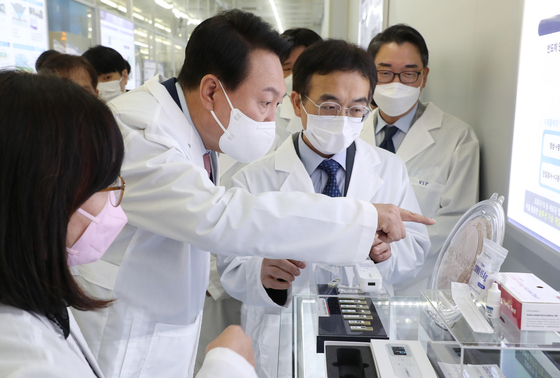
President Yoon Suk-yeol examines a semiconductor wafer at KAIST’s National NanoFab Center during a
visit to the school on April 29. [YONHAP]
Q. How is KAIST going to crack into the world’s top 20?
A. All efforts are based on our QAIST strategy: “Q” for question, as in fostering talented individuals with big dreams who pose questions; “A” for advanced research; “I” for internationalization; “S” for startup, as in creating global value through startups that can grow along with local society; and “T” for trust, as in creating a trustworthy school through innovation and communication. To this end, KAIST is actively cooperating with 290 institutes and universities from 65 different countries across the globe, mainly exchanging faculty and students, offering dual degrees, co-organizing academic conferences, conducting joint research, and sharing science and technology. We’re also collaborating with many developing countries such as Kenya and Egypt on ways to benchmark KAIST in their respective countries. Similar requests have been received from Turkey, Vietnam, Azerbaijan and Argentina. In New York, we’re in the process of establishing a campus there to expand our global research cooperation platform and allow our students to dream big.

KAIST Prof. Shim Hyun-chul briefs reporters about an unmanned racing car his research team developed
and won fourth place with at the Indy Autonomous Challenge, an autonomous racecar competition held as
part of the CES 2022, on Jan. 7 in Speedway, Indiana. [YONHAP]
Q. For those who are unfamiliar with KAIST, what makes it stand out from other Korean universities?
A. KAIST was founded in 1971 as the nation’s first university specializing in science and technology. Since then, it has grown into a university with the world’s best research and innovation capabilities, producing nearly 69,000 industrial leaders and science and technology brains who have played key roles in Korea’s development. A total of 1,224 companies are now run by KAIST graduates, which created 45,066 jobs and generated 18.6 trillion won [$14.8 billion] in revenues. Among these companies, 70 have gone public on the Kospi, Kosdaq or Konex. At a time when demand for talented individuals in science and technology to lead new industries of the future is growing across the world, KAIST is prepared to deliver. All our courses except a few electives have been conducted in English since 2008, which allows international students to easily blend in, and Korean students to enter the world stage without feeling any language barriers.
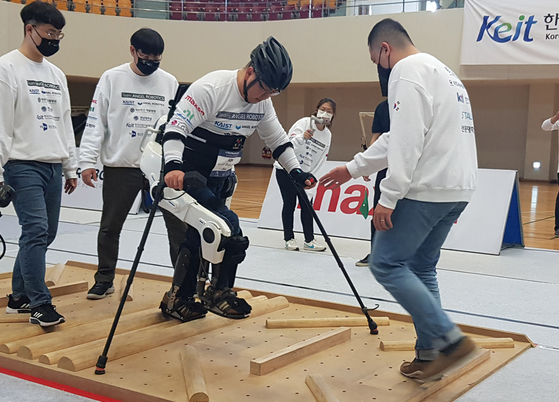
Kim Byeong-uk, who is paralyzed from the waist down, won the gold medal in the Cybathlon 2020,
a multi-sport event for disabled athletes, in a wearable robot developed by KAIST Prof. Kong Kyoung-chul
’s research team. [YONHAP]
Q. What kind of support does KAIST offer to international students?
A. In terms of financial aid, all international students receive full scholarships either from their governments, the Korean government, or KAIST. We also offer monthly living expenses. The first two months of dorm fees are waived for students from low-income countries. Free one-on-one Korean language and culture classes are provided every week for anyone who applies. We have a counselor who holds a Ph.D. [in counseling] and two other counselors who can speak fluent English working full-time on campus to offer advice to international students. There are even two full-time interpreters with a master’s in interpretation and translation who provide English interpretation for school events and meetings. In December 2021, we opened the Global Talent Visa Center with the help of the Ministry of Justice to provide visa-related services to our international students and foreigners working in the Daedeok Innopolis zone [a science cluster that houses KAIST and dozens of research centers].
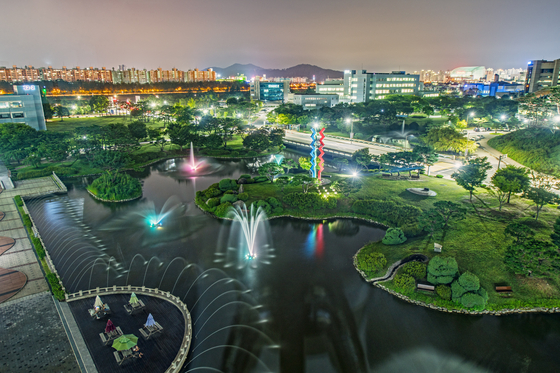
An arial view of the school’s iconic Duck Pond [KAIST]
Q. What’s your ideal image of a globalized campus?
A.We hope to be world-class. When we look at Samsung, LG, BTS and Bong Joon-ho [director of the Oscar-winning “Parasite” (2019)], they all began in Korea but never rested on domestic success. They did their marketing abroad. If Samsung only ran factories in Korea, it wouldn’t have grown into the world-class corporate powerhouse it has become today. That’s why we want to create a “world bridge” that connects many regions around the world like a multinational corporation. To do that, we need to dream beyond Korea and show our unique colors. We need to show something new, something that hasn’t been seen anywhere in the world. One very important ingredient here is freedom. I want students and professors at KAIST to think of the school as a playground where they can experiment with whatever they want, however they want.
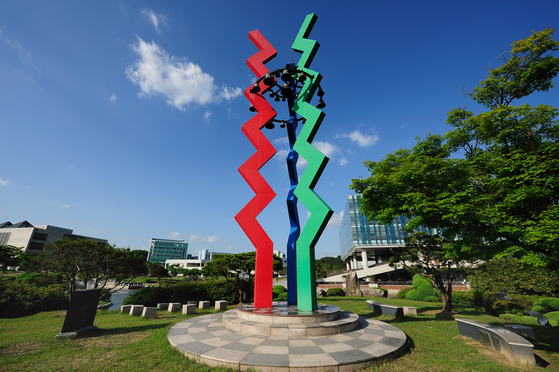
The Carillon of Great Scholars, a structure on the school campus that symbolizes science,
technology, and “beacon of hope for humanity” [KAIST]
Q. Over the years, KAIST has made great strides in future technologies such as artificial intelligence (AI), autonomous driving, bioscience and brain engineering. What plans does KAIST have going forward?
A.At a time when the global race for technological hegemony is intensifying, it’s our job to be at the forefront. Not only must KAIST educate the young generation, but it should also play a key role in scientific and technological innovation through research, and prepare strategies to secure emerging technologies related to national security. In part of such efforts, five universities specializing in science and technology came together with the Ministry of Science and ICT earlier this year to share research roles in 10 essential fields: AI, 5G and 6G, advanced biotechnology, semiconductors and displays, secondary batteries, hydrogen, advanced robots and manufacturing, quantum technology, aviation and space, and cyber security. KAIST plans to select three to five specific technologies in each field and devise a comprehensive strategy.
Lee Kwang-hyung is the 17th president of KAIST and a professor of bio and brain engineering. His four-year term as head of the school began in February 2021.
A futurologist who pioneered multidisciplinary studies and research at KAIST, Lee advocated that the convergence of information, biology and nano-technologies would be critical for future industries, playing a crucial role in the establishment of the Department of Bio and Brain Engineering in 2001 and the Moon Soul Graduate School of Future Strategy in 2013.
Lee has published more than 70 papers in international journals and textbooks on system programming, fuzzy set theory and its applications, and three-dimensional creativity. He also invented a "fuzzy elevator," subway operation controller and AI transportation controller. He was also decorated by the Korean and French governments in recognition of his innovative education and research achievements.
Lee completed his undergraduate studies in industrial engineering at Seoul National University and earned his master’s in the same field at KAIST, after which he earned a Ph.D. in computer science from INSA de Lyon in France.